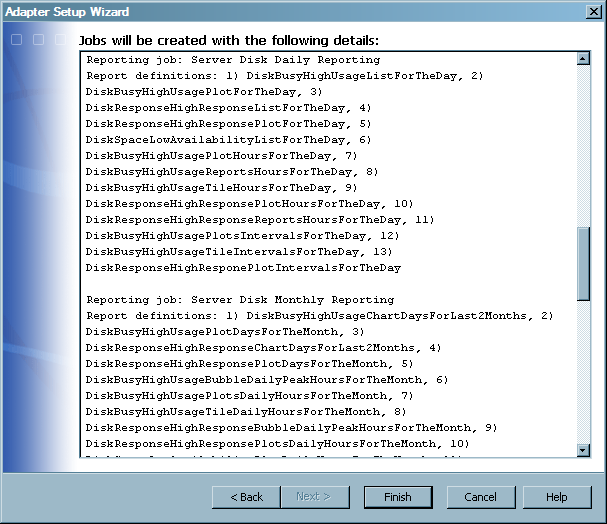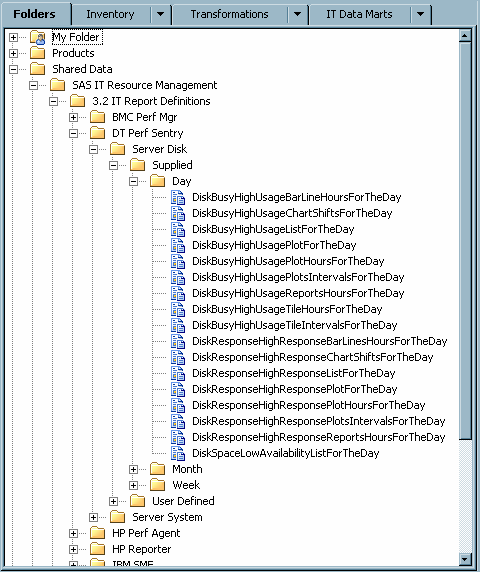Reporting Jobs and Objects Created by the Adapter Setup Wizard
About Reporting Jobs Created by the Adapter Setup Wizard
The Adapter Setup wizard
programmatically creates reporting jobs for the domain categories
and time periods that you might select. These reporting jobs are named
using the convention <domain subcategory>
<time period> (such
as Daily, Weekly,
and Monthly)> Reporting,
and they are stored in the same domain category folder as the aggregation
and information map jobs.
Reporting jobs include
Gallery transformations that use report definitions and information
maps to generate reports using data for IT resources. When a reporting
job executes, it creates the necessary report packages and reports
based on the information maps that are in the same domain category
folder. The reports are then saved as graphic files (such as HTML
or .png files) in the SAS Content Server that you selected in the Adapter
Setup wizard. For
more information about the reporting jobs that the Adapter
Setup wizard creates for specific domain categories and
time periods, see How to Determine Whether the Adapter Setup Wizard Will Create Reporting Jobs for Your Selections.
Note: The metadata server and SAS
Content Server must be running when reporting jobs execute or the
jobs will fail to generate output.
After a reporting job
is deployed, scheduled, and executed, the resulting report output
is available for viewing with Gallery Manager. Gallery Manager enables
you to access, filter, and manage your report content from a Web browser. For more information, see Working with the Gallery Manager.
How to Determine Whether the Adapter Setup Wizard Will Create Reporting Jobs for Your Selections
SAS IT Resource Management
supplies predefined report definitions for several domain categories
and time periods. These report definitions include information such
as the names of the variables, the report style, and other attributes
that are used to build graphical reports from your IT resource data.
The Adapter Setup wizard uses these prepackaged
report definitions in the reporting jobs that it creates for the domain
categories and time periods that you select.
Note: The prepackaged report definitions
that the Adapter Setup wizard jobs use were
created by the supplied SAS Enterprise Guide projects. If you want
to modify a report that the Adapter Setup wizard
creates, or if you want to create your own report that is similar
to one that the wizard creates, then you can use the corresponding
supplied SAS Enterprise Guide project as a template. To do so, copy
the supplied project and make the necessary modifications to create
a modified report definition. For more information
about how to complete this and other related tasks, see How to Create or Modify Your Own Batch Reports and Managing SAS Enterprise Guide Projects for SAS IT Resource Management.
If you select a domain
category and time period for which SAS IT Resource Management supplies
report definitions, then the Adapter Setup wizard
creates the appropriate reporting jobs. To determine whether the Adapter
Setup wizard is going to create reporting jobs for the
domain category and time periods that you selected, you can view the Summary page
of the wizard before you select Finish.
The Summary page
lists the report jobs that the Adapter Setup wizard
will create and the report definitions that the report jobs use, as
shown in the following image:
Example of a Summary Page Listing Report Jobs

You can also determine
whether the Adapter Setup wizard is going
to create reporting jobs based on your selections by viewing the list
of supplied report definitions for a given domain category and time
period. If SAS IT Resource Management supplies report definitions
for a given adapter, domain category, and time period, then the Adapter
Setup wizard creates a reporting job for those selections
based on the configuration level that you selected. If there are no
supplied report definitions for a given adapter, domain category,
and time period, then the Adapter Setup wizard
does not create reporting jobs for those selections.
You can also create
your own report definitions, Gallery transformations, and reporting
jobs. You can create reporting jobs to supplement those that the Adapter
Setup wizard creates. You can also add reporting jobs
for the domain categories and time periods for which the Adapter
Setup wizard does not create reporting jobs. Report definitions
that you create should be stored in the
User Defined folder
within the domain category folder. For more information about how to create your own report
definitions, see About the ITRM Gallery Task.If you decide to create
your own reporting objects and jobs, maintain consistency and efficiency
by using the same naming conventions and folder structure that SAS
IT Resource Management uses for supplied reports. For more
information, see How to Create or Modify Your Own Batch Reports and Naming Standards and Location of Objects.
Deploy and Run Jobs That the Adapter Setup Wizard Creates
The Adapter Setup wizard
does not run the jobs that it creates. You must run the resulting
jobs as needed. These jobs depend on one another to process the raw
data for reporting. For example, the aggregation jobs include aggregations
that rely on the staged tables that are generated when the staging
job is run. As a result, each job should be run only after the jobs
that it depends on have been run.
The following list shows
the types of jobs that the Adapter Setup wizard
creates and the dependencies of each. Each job type in the list is
dependent on the job type that precedes it.
-
staging job
-
aggregation job
-
information map job
-
reporting job
For more information, see Deploying and Running Report Jobs.
Note: Based on your specifications,
the Adapter Setup wizard might not create
all four types of jobs (staging, aggregation, information map, and
reporting) when it executes. For example, you might specify in the
wizard to create only a staging job. Or, you might select a supported
adapter for which the Adapter Setup wizard
does not create reporting jobs.
